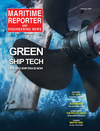
Page 31: of Maritime Reporter Magazine (February 2020)
Green Ship Technology
Read this page in Pdf, Flash or Html5 edition of February 2020 Maritime Reporter Magazine
“Looking at data in different segments is where the big opportunity lies to reduce fuel consumption, but it also requires taking down silos in the maritime world.” well-placed to assess fuels as they emerge. But for now, said well as ? exible powering are a necessity, said Holm.
Holm, the watchword is ? exibility. “A combustion engine is one part of it. The other thing is to “No one knows exactly which way fuels will develop but look at how you enable the use of data for your asset to the we will see a greater mix of fuels than we do today,” he said. greatest extent. The vessel you have today and the ones we “That’s where you need fuel ? exibility. And here the combus- will have in 10 years will be very different in how they use tion engine is one of a kind. Today, for example, you have data as well as the fuel they use. But to get where we need dual-fuel engines running on heavy fuel oil and LNG. In the to go, we can’t wait for three years until the path is clearer.” future it might be that you use a mix of hydrogen and LNG. One example of that rapid pace of change is the drive to-
You will need technology that is as future proof as possible wards vessel autonomy. Holm said that the pursuit of greater and that can be converted if needed.” autonomy is driven by a desire to further optimize operations,
Wärtsilä has supplied dual-fuel engines to the shipping and rather than reduce crew numbers. One example of this ap- power generation markets for nearly 30 years, and its engines proach is Wärtsilä’s work with harbor and towage operator can all be converted to use many clean fuels, including blends PSA Marine in Singapore to develop a smart tugboat that in- of green ammonia, hydrogen and methanol. But until zero- corporates multiple systems to enhance safety and ef? ciency. carbon fuels emerge at scale, LNG is a solid option. “For me the heart of this development is optimization,” he “We see an uptake of LNG as a fuel in all shipping seg- said. “We see it in the car industry already, where data is used ments,” said Holm. “It’s also a bridge to the future in the to optimize the usage of the battery and the engine in hybrid sense that LNG will still play a big role in the market in 2050. cars, and to help the driver to drive safely. It is similar in ship-
But using LNG now also enables ship owners to use other ping and while there are segments where unmanned opera- new fuels as they emerge, such as synthetic LNG, or to mix tion will be a target – in some coastal shipping for example fuels like hydrogen with LNG to reduce carbon content.” - we see increased optimization as the main goal of greater autonomy.”
Data Flexibility
Naturally, with its vast resources, Holm reckons Wärtsilä
The need for ? exibility also applies to the other side of is a trailblazer. “There are few players that can look at this equation – improving operations through data. With the rapid in a broader perspective. We are one. In fact, this its our pur- pace of development in both data use and fuels, there is a sig- pose of enabling sustainable societies with smart technology ni? cant risk of selecting the wrong technologies for a vessel extremely well. For us, to drive this development is to drive that must serve for 20 years or more. Future-proof systems as our business.”
ForSea Aurora Electric Ferry 1.9 million cars annually 7.4 million passengers
Zero Fuel, Emission Free
SPBES - Battery Power for Hybrid & Electric Ships www.spbes.com • [email protected] www.marinelink.com 31
MR #2 (18-33).indd 31 2/5/2020 10:57:12 AM

 30
30

 32
32
